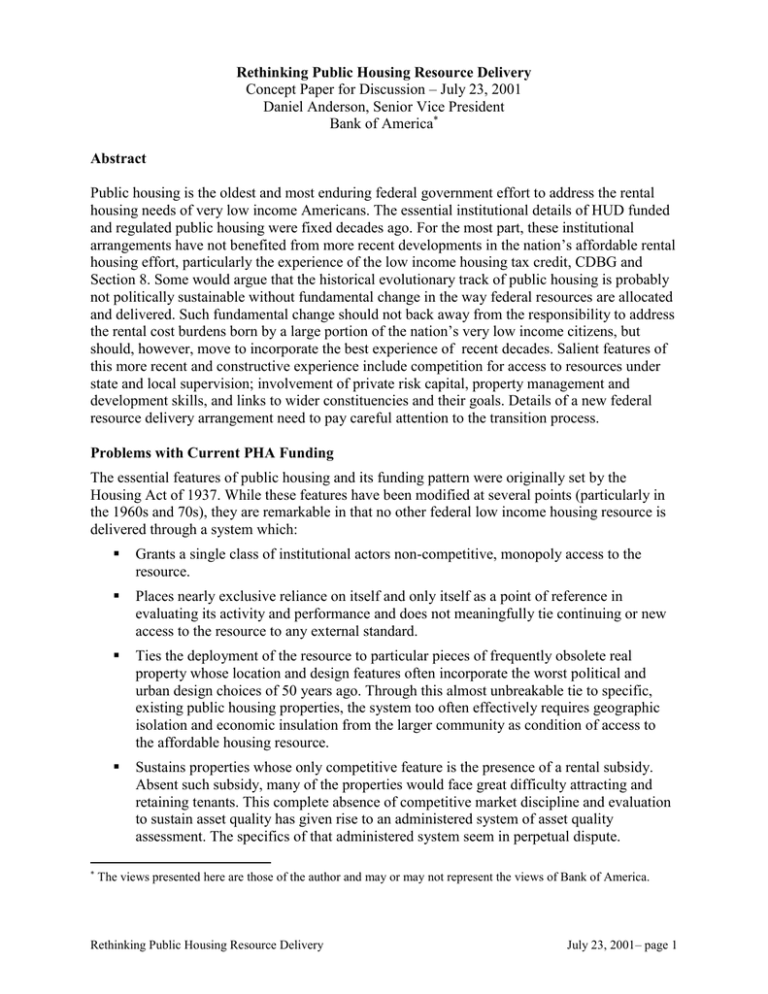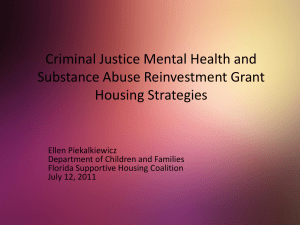Concept Paper for Discussion – July 23, 2001 Bank of America
advertisement

Rethinking Public Housing Resource Delivery Concept Paper for Discussion – July 23, 2001 Daniel Anderson, Senior Vice President Bank of America* Abstract Public housing is the oldest and most enduring federal government effort to address the rental housing needs of very low income Americans. The essential institutional details of HUD funded and regulated public housing were fixed decades ago. For the most part, these institutional arrangements have not benefited from more recent developments in the nation’s affordable rental housing effort, particularly the experience of the low income housing tax credit, CDBG and Section 8. Some would argue that the historical evolutionary track of public housing is probably not politically sustainable without fundamental change in the way federal resources are allocated and delivered. Such fundamental change should not back away from the responsibility to address the rental cost burdens born by a large portion of the nation’s very low income citizens, but should, however, move to incorporate the best experience of recent decades. Salient features of this more recent and constructive experience include competition for access to resources under state and local supervision; involvement of private risk capital, property management and development skills, and links to wider constituencies and their goals. Details of a new federal resource delivery arrangement need to pay careful attention to the transition process. Problems with Current PHA Funding The essential features of public housing and its funding pattern were originally set by the Housing Act of 1937. While these features have been modified at several points (particularly in the 1960s and 70s), they are remarkable in that no other federal low income housing resource is delivered through a system which: * Grants a single class of institutional actors non-competitive, monopoly access to the resource. Places nearly exclusive reliance on itself and only itself as a point of reference in evaluating its activity and performance and does not meaningfully tie continuing or new access to the resource to any external standard. Ties the deployment of the resource to particular pieces of frequently obsolete real property whose location and design features often incorporate the worst political and urban design choices of 50 years ago. Through this almost unbreakable tie to specific, existing public housing properties, the system too often effectively requires geographic isolation and economic insulation from the larger community as condition of access to the affordable housing resource. Sustains properties whose only competitive feature is the presence of a rental subsidy. Absent such subsidy, many of the properties would face great difficulty attracting and retaining tenants. This complete absence of competitive market discipline and evaluation to sustain asset quality has given rise to an administered system of asset quality assessment. The specifics of that administered system seem in perpetual dispute. The views presented here are those of the author and may or may not represent the views of Bank of America. Rethinking Public Housing Resource Delivery July 23, 2001– page 1 Provides little or no incentive for efficient operation of the affordable housing assets or for the involvement of other public or private resources or skills in their stewardship. Has been resistant to reconfiguration or redeployment without extraordinary regulatory difficulty and cost or without the injection of massive additional federal funding – e.g. HOPE VI. Has created little in the way of new assets other than via the HOPE VI program (which itself has resulted in a net decrease in assets). Enjoys a much lower level of popular and political support than do alternative modes of federal involvement, for example, the low income housing tax credit. The characteristics summarized above, while the product of both historical choice and institutional drift, are sustained by the current delivery system of federal public housing resources. Under this system, HUD expends approximately $7 billion a year (includes HOPE VI and PHDEP) under a series of Annual Contribution Contracts (ACCs) with each of the nation’s approximately 3,100 local housing agencies, almost all of which are special purpose local governmental entities known as public housing authorities or PHAs. The nation’s PHAs operate approximately 1.3 million dwelling units though not all of these units are on line and occupied. Statutory changes of recent years make it permissible for PHAs to redevelop their stock without reliance on HOPE VI and to serve a substantially wider portion of the low income spectrum. However, the competitive real estate characteristics of much public housing, a lack of incentives and institutional inertia have combined, in most PHAs, to thwart meaningful redevelopment or income mixing initiatives. The system continues to sustain a public housing resident population with an average household income near 15% of AMFI – in many areas this is under $7,000 / year. Clearly PHAs house the very lowest income Americans and almost only such extremely low income Americans. The largest share of the HUD public housing funding stream (more than $6 billion per year) flows as an entitlement to the PHAs and is not accessible by other developers or operators of low income rental housing. Public housing resources provided under individual ACC agreements with HUD may only be applied toward the operation and capital needs of specific, HUD approved, public housing assets or projects. Additionally, many details of project operation and the expenditure of the ACC resources are specified in a labyrinth of HUD mandated regulation. The absence of incentives for change, the rigidities and inflexibility governing the use of public housing and decades-old patterns of embedded practice are such that most public housing is systemically resistant to, and only rarely makes any use of private capital, private property management skills, or development capacities. Public housing communities are almost always isolated economically and are often isolated geographically from their larger communities. Indeed, in many locations, public housing is the only residential real estate asset types whose owner’s identity is readily apparent from casual “windshield” observation. This pattern of institutional, legal and economic isolation has left HUD as the principal—and too often the only—source of oversight of public housing. Though most PHAs have long waiting lists for admission to their public housing, this is less a testament to the quality of public housing assets and programs as it is testimony to the scarcity of Rethinking Public Housing Resource Delivery July 23, 2001– page 2 affordable housing for those in the very lowest fractiles of household income distribution. It goes without saying that expanded federal funding to address the housing cost burden of extremely low income households is needed. What is less clear is that the existing system of public housing resource delivery is the appropriate channel for either existing funding or for much needed incremental funding for this critical mission. Proposed Reform These patterns of insulation and isolation; of barriers to and lack of incentives for change, and; of obsolete, non competitive assets would not be possible but for the current pattern of federal resource allocation which delivers the public housing funding stream as a non-competitively awarded entitlement to single class of institutional actors whose patterns of practice are generally not informed by prevailing practice elsewhere in the world of low income housing development and stewardship. A fundamental change to the above pattern of resource delivery and its consequences is needed. That fundamental change should incorporate strong incentives for change and the best experience of recent decades while preserving the very low income focus of current programs. In addition to more flexible income targeting, the features of more recent and constructive experience which should be included in such a change in resource delivery include: Competition for access to resources under state supervision; Real estate which is competitively viable in its local market but where a certain portion of its tenants also enjoy a rental subsidy; Involvement of private risk capital, property management and development skills, and; Links to the wider community, other constituencies, their goals and their political support. This might be accomplished by a series of coordinated changes such as those outlined below. These proposed changes in federal public housing resource delivery draw heavily on the best aspects of HOPE VI, of the low income housing tax credit, and of private for profit and not for profit development and stewardship experiences of the past two decades. The suggested changes are: 1. Combine and block grant the two principal existing public housing resource streams (capital grant and operating grant – not Section 8). Pass the resulting block granted resources to an agency of state government for periodic allocation pursuant to a competitive process open to a range of entities and not solely to local PHAs. 2. The devolution to the states should be “strong” devolution where HUD’s local agency and project level oversight roles are effectively curtailed. The devolution would be structured so as not to impose detailed, wide ranging compliance and administrative burdens and costs on the states. Project level regulatory oversight would be delegated to the state agencies responsible for awards and will emphasize compliance with tenant income and rent level targeting requirements. Like LIHTC, the program would rely on the underwriting and asset monitoring discipline of private capital suppliers and on the competitive mixed income nature of the developments to incent the stable, long-lasting stewardship of the resulting real estate assets. HUD would not provide any local level Rethinking Public Housing Resource Delivery July 23, 2001– page 3 regulation or compliance monitoring. Federal agency oversight would be limited to a periodic review of overall program performance and effectiveness at a national level. 3. The competitive award process for the block granted resource stream would be subject to certain federally specified threshold and income targeting grant allocation criteria. States may add additional criteria so long as the additional criteria are not in conflict with federal criteria. 4. The criteria and federal award sizing rules would provide strong incentives for meaningful involvement of private risk capital. Award criteria would favor developments which are coordinated with local urban revitalization / housing initiatives and have a material, local (non-federal) match. Scoring would incent / reward developments which link residents to services / human capital development as may be appropriate. Cooperative programs with public and private providers of such services would be incented / encouraged. Subject to the other criteria listed here, the award process would reward efficiency and prudent long term stewardship. It would not create (or at least would minimize) “take the money and run” incentives. 5. Existing local public housing authorities could apply for the resulting competitively awarded grants. If successful in the award competition, local agencies could use the grants in conjunction with existing public housing or in any other manner contemplated by the new block grant program. Joint ventures / partnerships with for profit and not for profit partners would be encouraged. 6. Any other non profit or for profit motivated owner / developer / operator of qualifying affordable housing who meets state and federal threshold criteria and targeting requirements could also apply for block grant awards. 7. Block grant awards could be used for capital or operating support purposes or for both. Awards might be used for new construction, acquisition, modernization, or preservation of existing federally assisted properties. 8. The resource referred to here as a “block grant” could assume either the form of a funded federal expenditure or the form of a federal tax credit-incented, private capital investment. If the tax credit model is utilized, new rules governing eligible investments and compliance requirements would need to be developed. 9. If the funded federal expenditure model is utilized, the program should provide for both one time “current value” awards and for annuitized awards. Current value awards would generally be used for capital investment purposes. Annuitized awards could be used for operating purposes and / or debt service support. Annuitized awards would be contractually committed for the requested term of the annuity and would be scored or counted at the present value of that requested annuity. Annuitized awards could be “level pay” or could be tied to a local cost of living index. The latter will be scored at a larger value than the former. Annuitized awards would be structured so as to permit private sector financing against the annuitized award. If the block grant is used for an annuitized operating subsidy, resulting effective rental income would not be subsidized to a level greater than that available from local market rents. 10. Existing public housing procurement and operating rules and regulations would not apply to properties developed, acquired or subsidized under this program. PHAs will continue to be governed by state and local public procurement requirements. Rethinking Public Housing Resource Delivery July 23, 2001– page 4 11. There would be no federal limits on cash flow to owner / sponsors. States would be prohibited from imposing such limits so long as benefiting properties are in compliance with federal program threshold criteria. Project cash flow could be used to support services where appropriate. Maximum leverage / minimum coverage financial structures would be discouraged. 12. While the use of the block grant would be compatible with syndication or other factoring processes, it would not require such factoring as a practical condition of deployment. Income Mixing The new block grant award federal criteria will be designed to require that any development using the new block granted resource have a bona fide mixed income character. Within a mixed income development, block grant proceeds may only be applied to units occupied by households having incomes which correspond to the existing public housing income targeting requirements of QHWRA. Federal threshold criteria will require that applications for block grant resources be scored to incent / recognize the deeper levels of capital and operating subsidy required for extremely low income households. This is intended to provide substantial assurance that the block grant resource remains focused on households earning < 50% AMFI. Transition Issues While there is a wealth of detail which would need to be specified in the course of implementing the resource delivery reform outlined here, several issues are worthy of immediate note in an effort to ease the transition process and broaden the base of political support for these reforms: Tenants in good standing of existing public housing should be eligible to receive enhanced Section 8 vouchers if they elect to leave that existing housing in conjunction with the local implementation of the reforms proposed here. Local agencies could use the enhanced vouchers in conjunction with new acquisitions or new developments which otherwise meet the criteria outlined here. Existing public housing real estate could be sold or it could continue to be operated by the local agency without ACC support. Existing HUD use and operating restrictions would be ended together with existing ACC support. If existing public housing is sold, sale proceeds might be retained by the local agency if those proceeds are used according to state block grant award criteria. Otherwise sale proceeds would be returned to a national block grant pool. To the extent necessary to provide reasonable assurance to private parties who have played a pioneering role in supplying private risk capital to HOPE VI and other mixed finance developments, transition arrangements should include a hold harmless mechanism designed to buffer such entities from the adverse consequences attributable solely to the programmatic changes proposed here. State allocating agencies might permit small (i.e. < 250 units), local agencies with reasonable PHAS scores to opt out of all of this and continue as in the past if they elected to do so. It might also be politically useful / expedient to provide some type of voluntary opt-out mechanism for existing seniors-only public housing which is in good physical condition today. Rethinking Public Housing Resource Delivery July 23, 2001– page 5 The enabling legislation should provide for one time, limited duration technical assistance and capacity building grants to PHAs electing to make the transition to life after ACC. The services contemplated by these grants should be delivered by intermediaries (e.g. LISC, Enterprise) and private consultants experienced in the delivery of capacity building to community based organizations and similar entities. The capacity building and training should take place in a learn-by-doing context which integrates the training with the practical implementation of a project which uses the new block grant as a funding resource. The implementation of the reforms proposed must be deep and systematic. It can not be a half-hearted effort burdened by political compromises with roots in an effort to preserve the existing order. Down that path lie worst-of-both-world vagaries of California-style electric power deregulation. The federal commitment to reforming its involvement in extremely low income rental housing deserves better. __________________________________________________________ Daniel Anderson Daniel.S.Anderson@BankofAmerica.com Mr. Anderson is a Senior Vice President with Bank of America’s Community Development Banking unit. Mr. Anderson is also an officer of Banc of America Securities LLC where he has specialized in housing and community development uses of municipal securities. Mr. Anderson leads the Bank's overall effort to provide products and services relevant to the nation's public housing industry as it strives to redefine and reposition itself today and in the years to come. Mr. Anderson has been actively engaged in financing public housing authorities since the mid 1980s. Recently he pioneered the development of the Bank's credit product offerings relative to the HUD receivables financing needs of public housing authorities. He has been particularly active with efforts by PHAs to diversify their holdings, to reoptimize their real estate portfolios and to accelerate the transformation of public housing. Mr. Anderson is the Bank’s principal representative to the NAHRO Access Alliance, a joint venture of the Bank, NAHRO, the Enterprise Foundation and LISC, which is dedicated to assisting local public housing authorities seeking to transform themselves to more effectively serve their communities. Mr. Anderson has also been actively involved in local, non-federally supported initiatives to acquire, to preserve and to develop affordable multi-family properties for local housing authorities and for 501(c)(3) corporations. Mr. Anderson is active in the Community Development Banking Group's product and institutional relationship development efforts. In 1998 Bank of America was named by Fannie Mae as the nation's first Special Affordable Housing lender, a relationship negotiated by Mr. Anderson. Mr. Anderson is a Bank of America representative to the Brookings Institution's "Growing Competitive Cities" project. Rethinking Public Housing Resource Delivery July 23, 2001– page 6




